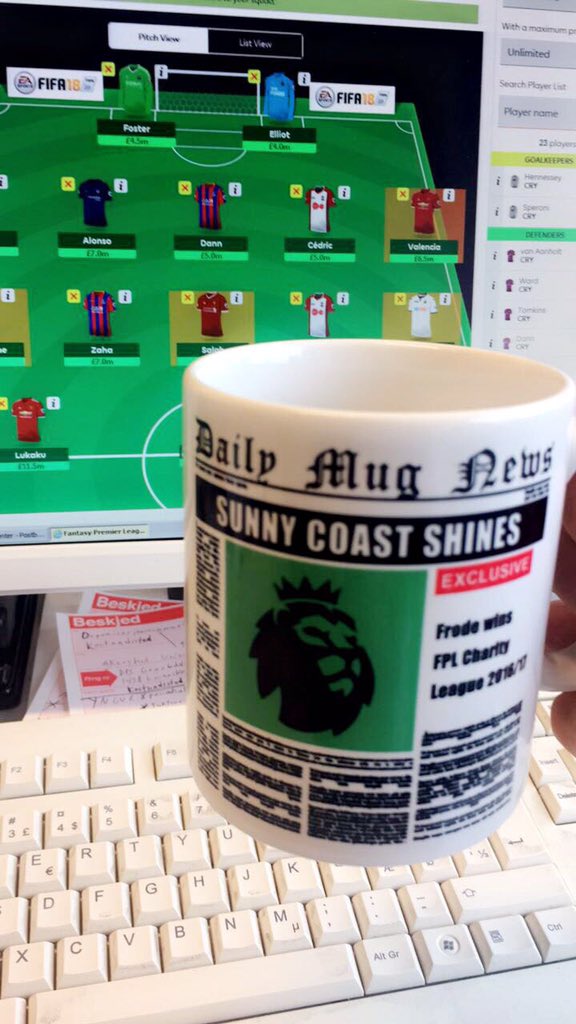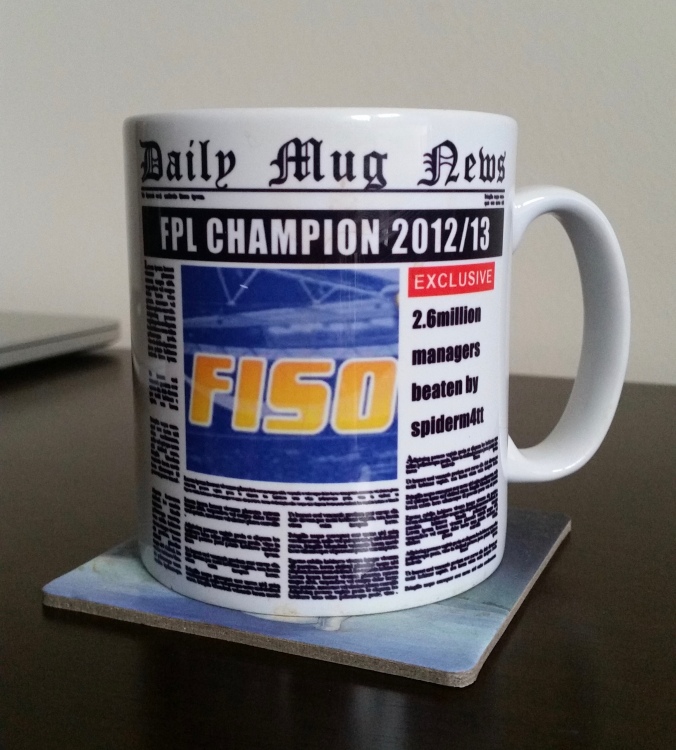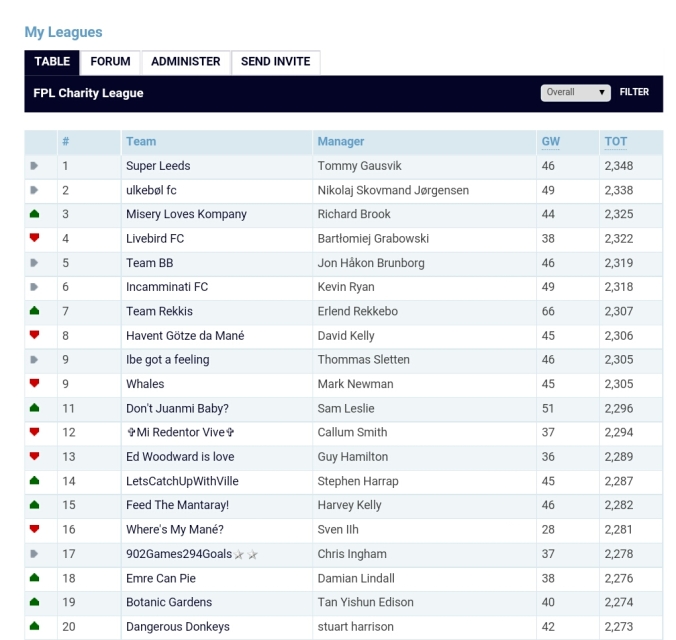The Fantasy Premier Leage run-in, the Double Gameweeks, and the Chips; My thoughts…
On the Eve of the Fantasy Premier League (FPL) Gameweek 32 (GW32), and in the following days and weeks to come, I along with many other FPL managers out there will have a lot of thinking and pondering to do about how we are going to manage our FPL teams safely and securely over the remaining seven GWs of the FPL season, whilst at the same trying to time maximise our FPL scores each GW in order to have a good strong finish and hopefully help us achieve our FPL goals and objectives.
What we know:
We now know that the missing Premier League fixtures from GW27, GW30, & GW35, have all been rearranged to midweek matches, and these rearranged fixtures have given us the FPL Double Gameweeks (DGWs) that we anticipated at the start of the season when the Premier League fixtures and the FA Cup dates were announced.
A DGW is where a team has two fixtures in a single GW instead of the usual one fixture in a single GW, and therefore, it gives the opportunity for players that are playing two fixtures to potentially score more points that GW than those who just have the one fixture, simply because they have more minutes on the pitch to do so!
Three Double Gameweeks upcoming!!!
There are three upcoming DGWs, starting with a small DGW33 with only Everton and Crystal Palace that have two fixtures. The other two DGWs are in GW34 and GW37, where there are a greater number of teams involved in these two DGWs giving us two big, or bumper, DGWs!
The DGW teams with….
Three DGWs:
Everton DGW33, 34 & 37
Two DGWs:
Crystal Palace DGW33 & 34
Liverpool DGW34 & 37
Manchester United DGW34 & 37
Watford DGW34 & 37
West Ham United DGW34 & 37
One DGW:
Arsenal DGW34
Manchester City DGW34
Newcastle DGW34
West Brom DGW34
Chelsea DGW37
Norwich DGW37
Sunderland DGW37
No DGWs:
Aston Villa
Bournemouth
Leicester City
Southampton
Spurs
Stoke
Swansea
As you can see above there are lot of teams who have DGWs, and at different times, and with some teams having more than others. Note that only one team, Everton, have three DGWs, while Liverpool are the only team who have two DGWs and without a blank GW. There are also seven teams, including the top two form teams in Leicester City and Spurs, who have no DGWs, and these teams also have no blank GWs.
Note: Be wary of the six teams that have a blank GW35. These teams are: Everton, Crystal Palace, Manchester United, West Ham, Watford, and Norwich. Apart from Norwich, the other other five teams have DGWs prior their blank GW35, so loading up on too many of those players for the DGW34 may just find that subsequently you won’t be able to field 11 players in GW35 without transfer points hits.
Though Everton have three DGWs, two of them, DGW33 & 34, are back-to-back, and therefore, it means they have to play four Premier League games in just eleven days. To add to this, only three days later they have a FA Cup semi-final match to play against either Manchester United or West Ham United. Five fixtures in just two weeks for the Toffees may just see some rest, rotation, injuries, for some key players, as Martinez will recognise that fielding his strongest team in the FA Cup semi-final will give Everton a good chance of making the cup final and therefore becoming possible FA Cup winners.
Also note that Liverpool and Manchester City are still in European competition. Liverpool’s second match of their Europa League double header with Dortmund comes just three days before the first of their two DGW34 matches. Given that there’s now a Champions League place guaranteed for the winners of the Europa League, this may be Liverpool’s best route back into Europe’s elite club competition as their Premier League form this season is hit and miss. And with Liverpool having to play a total of seven games over the next three weeks starting from GW32, Jurgen Klopp will have to ‘manage’ his squad carefully and he may decide to prioritise the two Europa League games, therefore, it is possible that some of the key Liverpool players may see reduced Premier League minutes over the next three weeks at least.
Manchester City, along with Liverpool, also have seven games over next three weeks with their second match too of their Champions League double header with PSG being only four days before their first DGW34 match. However, they still have something to play for in the Premier League. While it’s likely that the Premier League title may be out of reach for them, they won’t give it up just yet. Also there is a chance they could slip out of the top four, and the team that could displace them could be their rivals and neighbours, Manchester United. Therefore, there might not be as much rotation here with City’s big players, but there could be some reduced Premier League minutes for the likes of Aguero, Silva, Yaya, KdB by early substitutions or even some rotation (if not injuries!), as the potential prize of a Champions League semi-final place, and maybe a final, is in the offering.
Chips:
This FPL season is like no other FPL seasons gone by, in that we have the addition of ‘Chips’. These Chips, mainly the Bench Boost (BB), Triple Captain (TC), and the 2nd half of season Wildcard (WC), are new ways and opportunities to allow for potential extra FPL points if played well. I know from the FPL community, and also from reading some FPL forums, that some FPL managers may have already played some or all of these Chips by now. But I also know there are a lot of FPL managers out there, including myself, who have been saving all or the majority of these three Chips to play in the future DGWs.
For those FPL managers who have all three main Chips left (or at least two main Chips left) at this stage of the season, it really does offer us some decent hope and expectation to turn our season around and shoot up the overall and mini league rankings. If you’re already doing well and are having a good season, it gives you the opportunity to consolidate your good position, and then build upon what you have to secure you overall FPL goals.
But how and when do we play these Chips…?
I have mentioned in one of my previous articles that the BB and TC look to be the best Chips to help enable score the most points, and even more so if they are utilised in a DGW. Furthermore, if the WC is played appropriately around the DGWs to set your team up (or to clear up and set up) accordingly in conjunction with the other chips, then you will give yourself a good chance of some big DGW points, while at the same time not ignoring the single GWs.
The latter point above about not ignoring the single GWs is important to enable finishing well as we can often get ‘blinded’ by the upcoming DGWs, and therefore, we can take our eyes off the ball regarding the single GWs. Consistency is key to doing well in FPL, and that consistency applies to each and every one of the thirty eight GWs available, as every single point gained in every single (and double) GW can be significant in end….I can vouch for that!
Regarding the WC, I have always said that you should play it when you feel you need to use it. This new 2nd half of the season WC though has enabled a lot of FPL managers, including myself, to save it for the DGWs that we now have.
Either playing the WC before a DGW to set up your team, or playing it in between DGWs – ‘to clean up and set up’ – look to be the appropriate and best ways to utilise this Chip for the final run-in this season.
I have to admit in having a WC at this late stage of the season is rather strange and new territory for me as I’m usually an advocate of playing the early WC! Nonetheless, it’s exciting at the same time, especially with multiple DGWs and the additional BB chip!
Three different ways to utilise WC this season…
Option 1) You can use your WC now prior the GW32 deadline. This may not be the most popular choice – but it can work, especially if you currently have players with injuries, suspensions, players out of form, not got the ‘right’ players in, you want to make an early move, playing ‘catch up’, maximising the small DGW33 opportunity, whilst setting it up to maximise the bigger DGW34, you want to help try and ‘get ahead of the curve’ and ride the ‘FPL wave’.
If you play your WC this GW32 then it would be probably ideal to roll over your free transfer in GW33, and then same again in DGW34, so you can have two free transfers to remove your blank GW35 players before the GW35 deadline. Or even in DGW34 you take out the blank GW35 players, in particular those players who do not have a further DGW37 (Such as Crystal Palace players for example), and you can bring in some other DGW34 and/or DGW37 players who also have a GW35 fixture (From Chelsea or Sunderland for example).
Subsequently you can play your BB in DGW34, then TC in DGW37, if not play TC before in DGW33.
Option 2) You can play the WC prior the DGW33 deadline, which means you can use your GW32 transfer/s to have a one GW punt for GW32. Like Option one, you can set your up team to maximise the upcoming back-to-back DGWs 33 & 34. You can either go ‘all out’ on the DGW34 with 15 maximum DGW34 players, or leave in a few good quality single GW players who have decent upcoming fixtures, including the shortened GW35. The BB chip in DGW34 then looks to be the next best chip to use, followed by the TC in DGW37.
Option 3) You can play the WC post DGW34 to clean up your team to then set it up for the DGW37. Prior to the GW36 deadline looks the ideal time for the late WC. This allows you to load up on DGW37 players and therefore utilise the BB chip during this DGW37. The TC can be played in DGW34, or even in DGW33. Going down this GW36 WC route allows you to keep the highly owned and in-form single GW players from Leicester and Spurs for example.
Remember; you are only allowed to play one chip per GW. So if you’re wanting to play the BB or TC in a DGW then you will need to play the WC in the GW/s before/after the DGW.
Note; every single point in every GW counts, and the DGW33/34 teams that are Everton, Crystal Palace, Manchester United, West Ham, Watford, all have a blank GW35 (no game). So make sure when panning transfers (including WC) that you have enough players starting in GW35 (ideally starting 11 players and preferably with at least one bench cover. You may though get away with only 8/9 players, or with 11 players from taking multiple -4pt hits, but this is not an ideal way to maximise your GW points).
Quality versus Quantity:
In DGWs it is important to have a good proportion, if not all, of your team having two fixtures instead of one fixture to simply give you the chance of maximising your DGW points potential. If you get this ‘right’, then the likelihood is that you’ll get a nice big green arrow to help you sail up the rankings and past your rivals. However, I will stress and state from experience that quality players who have one game can often outscore, or at least match, a DGW player of lesser quality. Having a player with two fixtures in a GW, especially of lesser quality, does not guarantee you more points, therefore, it’s important to get the quality of players and the balance right.
The optimum balance of DGW players versus single GW players, however, is not a constant or a definite, and it can differ from one DGW to the next, season after season. The optimum balance though is likely to be determined by the quality (and form) of the Premier League players, their teams (their tactics, form, ambitions, goals), their fixtures (favourable, moderate, difficult, congested, rotation risk), and then relating it to the FPL game itself.
In the past – including my FPL title winning season – I have held off, and even out scored, teams around me who had more DGW players than I did. My greater explosive quality of single GW players were more than a match for their lesser quality and none explosive DGW players. There will most probably, however, be a cheaper and lesser quality player or two that will have a good FPL DGW, because that’s FPL – and that’s football. FPL, like football, can be unpredictable even at the best of times!
High fliers Leicester City and Spurs and their quality single GW players have some favourable fixtures up to GW35. It’s feasible to suggest that Mahrez, Vardy, Kane, Ali et al, and their fellow defenders, could score equally, if not more points, than some or most of the DGW players, especially those lesser quality DGW players who then have tough following single GW fixtures.
Your FPL strategy/tactics?
My advice would be for you to play your own game in relation to your overall FPL goals, and then play this in relation to the FPL game itself and the situation around you. For example, if you are doing well and are top, or close to the top, of the rankings and your mini-leagues, then have a look at your opponents around you and see what they are doing, what players they have, have they already played their chips? As they try and catch you they may take some risks and unnecessary gambles and therefore make mistakes, leaving you climbing further ahead of them.
Personally, if I was up there at top end of rankings again I’d be inclined to hold out for a late WC, or play a ‘safe’ DGW33 WC with a mix of top quality DGW and single GW players who are moderate to highly owned and then balance this off with just a few top quality lower ownership players. Simply because you’ve no need to gamble or take risks, and at the same time you can play the percentage ‘game, within a game, within a game’ tactic – in that you not only play the FPL game, but you play the FPL situation around you also.
If you are not doing well this season and you need to play catch up, then playing an early WC in GW32 or 33 and going mainly al out against the ‘template’ may just be the only way to go. By going against the template form players you really have to hope that not one, but two things go your way over most, if not all, of the remaining seven FPL GWs. This is one; that the players you get in score well, and two; that the template form players you do not own do not score well. It’s a big ask and a big risk, but the rewards if it pays off could be huge. If it doesn’t pay off you’ll probably see not just red arrows, but most probably big reds arrows.
My own team and strategy/tactics/plan for the run in:
I have to admit it is difficult for me to see at this moment in time which route is the best option for my FPL team, strategy, tactics, and overall goals. All three of the options mentioned earlier when to play the WC followed by the BB and TC can or cannot work out. What will work for one FPL manager, will not work for another.
However, what I do know at this moment in time is that my FPL team is more or less nicely set up for the very next GW, that is GW32. I also have the luxury of two free transfers to play with. My team set up the way it is currently, along with the two free transfers, allows me in a way to ‘buy more time’ without committing myself tonight to any given strategy. So for me Option 1) in playing WC prior this GW32 may not be for me.
If I do not choose Option 1), and I decide to go with Option 2), I could then use my two FTs and have a punt to strengthen my GW32 team as I know I could use my WC prior the DGW33 deadline. This option is very tempting and it may be my preferred option in the end.
If I decide to go with Option 3), I can use my free transfers (and maybe a hit if needed) to bring in some DGW33/34 players, to enable me to field around 3 or 4 DGW33 players, and then be able to field around 8 or 9 DGW34 players. I can then ‘clean up and set up’ my FPL team with my WC in GW36 to then allow me to BB in DGW37, whilst taking into consideration the decent GW36 & 38 fixtures these DGW37 players have, and also the decent single GW35 fixtures my already players from Leicester, Spurs and Arsenal have.
The GW36 WC route I feel also allows an advantage in a way to enable me to see what’s what nearer to the time, in that it allows me to see what players are fit and in form, not suspended or on the verge of suspension, and also what teams have something to play for in the final three GWs. It is near impossible to predict exactly from this far in advance what will be what in the final two weeks of the Premier League season. Also the GW36 WC route allows me to keep my high flying single GW players who have some decent fixtures from GW32 to GW35.
I have to admit at this moment in time that I am slightly favouring Option 3) only just over Option 2) for reasons I’ve mentioned above. However, I’m kind of playing catch up at the moment in all my leagues including the overall rankings, and an early WC tonight or for GW33 could give me the much needed springboard to jump up the rankings.
But if I apply my tactics that have served me well in FPL in the past that are highlighted in my ‘Consistency is Key’ article, and that I’m ‘playing the game, within a game, within a game’, then my ratio of moderate to high ownership quality players and quality differentials, along with DGW players to come in with free transfers, and utilising my TC in DGW34, then I may just continue creeping forwards back up the ranking as I’m doing at the moment with maybe an additional large one or two green arrows thrown in. I can then go ‘all out’ in the final block of three GWs of the season with a strong GW36 to 38 WC team/squad and get in the maximum 15 DGW37 players where I can utilise my BB!
I usually like to play the FPL game in blocks of three GWs at at time, but also trying to maximise the very next GW. For example, when picking players for the DGWs, I also look at their fixtures prior and post the DGW. Man City, Liverpool, and Arsenal to an extent, are an example of having decent single GW fixtures before and after their DGW34. Further ahead, DGW37 teams such as Chelsea, Man Utd, Everton, Watford and possibly Liverpool, have moderate to decent fixtures in GW36 & 38.
That’s it for now..!
Whatever your strategy is for the FPL run-in, be committed to it and trust it. However, don’t be afraid to change things if needed as FPL, like real football, is dynamic game that can change weekly if not daily! And after all it’s only a game, so have fun and enjoy it as the final part of the FPL and Premier League season is usually the best part and most exciting part of the season.
Best wishes for the remainder of the season!
Matt 🙂






 Back the summer of 2014 during the World Cup that was held in Brazil, the amazing FPL community raised £115.74 for TASK Brasil in the World Cup Charity League.
Back the summer of 2014 during the World Cup that was held in Brazil, the amazing FPL community raised £115.74 for TASK Brasil in the World Cup Charity League.
















